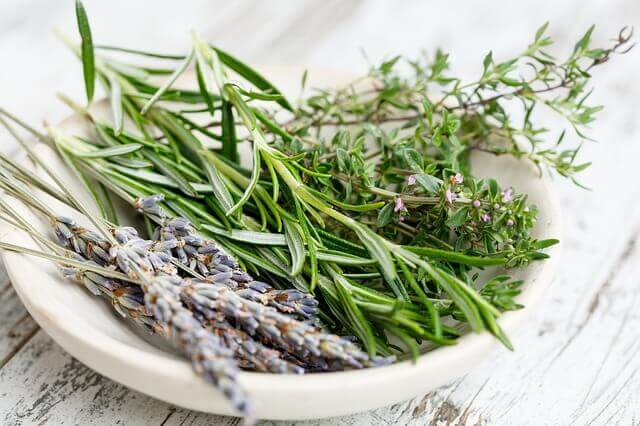Hey! By the way… TheEdibleTerrace is reader-supported. When you buy through links on our site, we may earn an affiliate commission and as an Amazon affiliate, we earn from qualifying purchases. Thanks in advance for your support!

Fresh herbs are a wonderful addition to meals, providing great flavor and health benefits. The amazing thing is that there are plenty of herbs you can grow in your house without the need for a home garden. All you need is a few windowsills with proper sunlight (south-facing is best), water, and a few plant pots.

Seeds Now All-In-One Culinary Herb Variety Pack – Get everything you need in one pack to get started growing your Kitchen Herb Garden!
- Basil – Basil is an amazingly versatile herb that can be used for just about anything, from pesto to sauces or even frozen desserts like watermelon sorbet. Basil offers a nice peppery mint flavor and is said to be a powerful antibacterial.
- Chamomile – Chamomile is an herb traditionally used as medicine due to its anti-inflammatory and calming properties. Chamomile is best in teas to help ease an upset stomach or help you sleep.
- Chives – Chives have a mild onion flavor that goes great with soups and vegetable dishes. Add chives to butter or cream cheese to make a savory spread.
- Lavender – Lavender is a beautiful herb that can be used in foods or even for cosmetic uses like homemade face masks. Lavender can help ease anxiety and depression and has anti-inflammatory properties.
- Mint – Growing mint indoors is actually a better option overall because mint tends to run wild and take up the whole garden. Keeping mint by itself, in a small container, will control the growth. Use mint to enhance the flavor of water or even throw it into a delicious smoothie.
- Oregano – Oregano is a bright green leafy herb that is traditionally used in Greek or Italian dishes. Oregano has a strong but appealing flavor, so a little goes a long way.
- Parsley – This bright green leafy herb has a peppery flavor that is traditionally used as a garnish but can also make a great flavor enhancer to many protein dishes. Parsley is also an anti-inflammatory and high in vitamin C, calcium, iron and fiber.
- Rosemary – Rosemary is a highly aromatic herb that has wood-like stems and short pine-like needles. This herb can be used by itself as an air freshener or used to enhance the flavor of meats like lamb, pork, and chicken.
- Sage – Sage is an aromatic herb that has a bitter taste that pairs best with dairy. This herb is high in antioxidants and helps improve digestion.
- Thyme – This herb is used in the Mediterranean, Italian and French dishes that we all love. It’s also often paired with other herbs such as rosemary, parsley, and oregano. Thyme has a sweet, pungent flavor and has small leaves with a woody stem.

8 Tips For Growing an Herb Garden Indoors
[easyazon_infoblock align=”right” identifier=”B079F4G8JB” locale=”US” tag=”edibleterrace-20″]
- Adequate Sun Exposure – Most herbs need sun for about six to eight hours a day, so make sure you find a location in your house that offers this amount of sunlight. Proper sunlight is also responsible for the flavor of your herbs. The more sunlight they get, the better the flavor.
- Proper Temperature – Keep the temperatures in your house or the room the herbs are located in at around 65 to 75 degrees Fahrenheit. If you need to reduce the growth of herbs, reduce the temperatures to about 60 degrees Fahrenheit.
- Water – Herbs need a moderate amount of water daily. It is best to keep the soil of herbs damp. Watering can easily be forgotten, so make a plan and keep to a schedule. Remember, since the herbs are indoors they do not get water from rain, so it is up to you to keep up with it.
- Keep Herbs Separate – For long-term success, you should keep your herbs separate. This way they can each get the individual attention they need. It also helps with plant rotation, and if one plant gets infested with pests the others don’t have to suffer.
- Proper Containers – Containers need to have proper drainage so that the herbs are not sitting in too much water. Add a thin layer of rocks to the bottom of your pots before filling with soil to allow the water to settle there instead of in the soil. You may even want to poke or drill a few holes in the bottom of the container – if they don’t already have some.
- Rotate – Herbs need proper rotation under the sun to help with air circulation and to prevent mold. Turn your plants or rotate them a little every day so that each side gets the right amount of sun. This will also promote even growth.
- Soilless Potting Mix – Indoor herbs need special attention when it comes to soil because it needs to provide more drainage. Dirt from the ground is too compact and usually less nutritious. Make sure you pick a soil that is listed for indoor gardens.
- Feed with Fertilizer – Fertilize your herbs once a week to promote strong growth. The best fertilizers for herbs are seaweed extract or fish based.
Conclusion
Keep these tips in mind when starting or growing your indoor herb garden. This way you are sure to have a garden that will keep up with your delicious recipes. You’ll wow your family and your guests.
The best part about having an herb garden in your kitchen is that they are readily available. Readily available herbs also have the best flavor and health benefits. Plus, they unleash creative cooking ideas.

